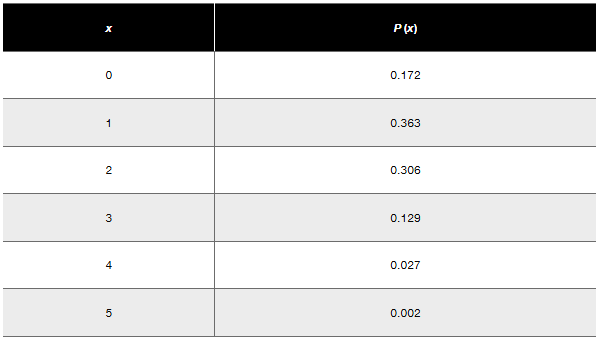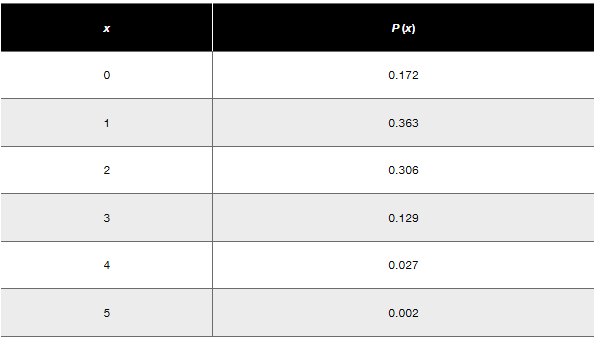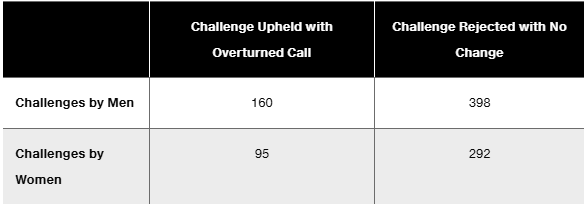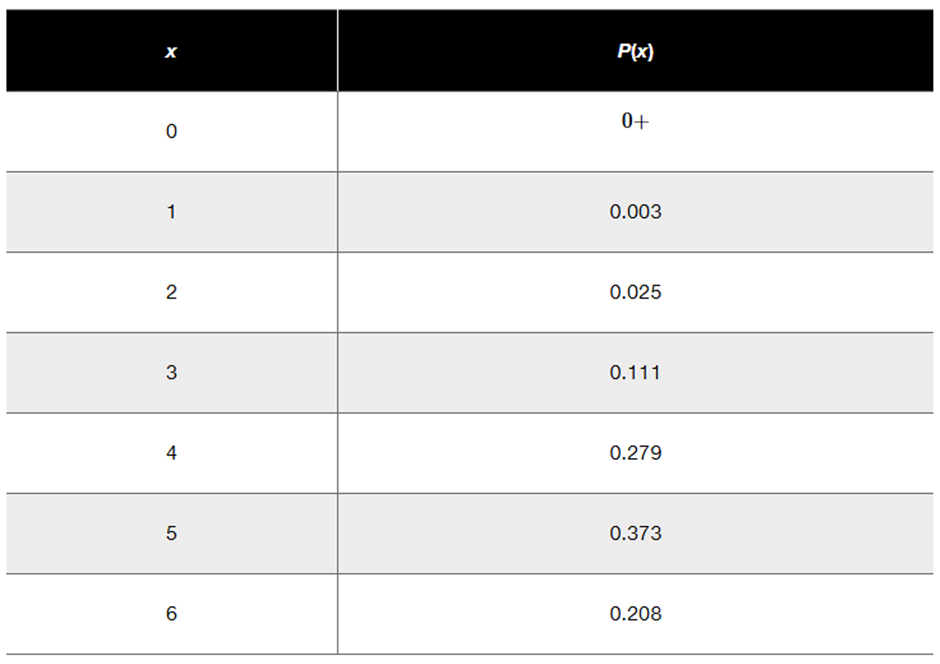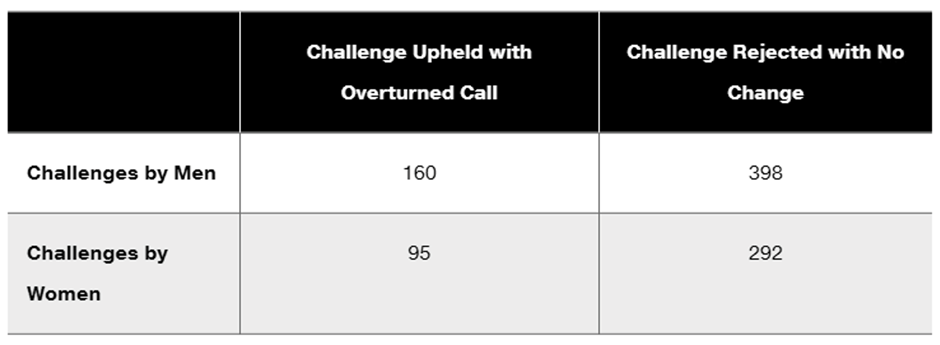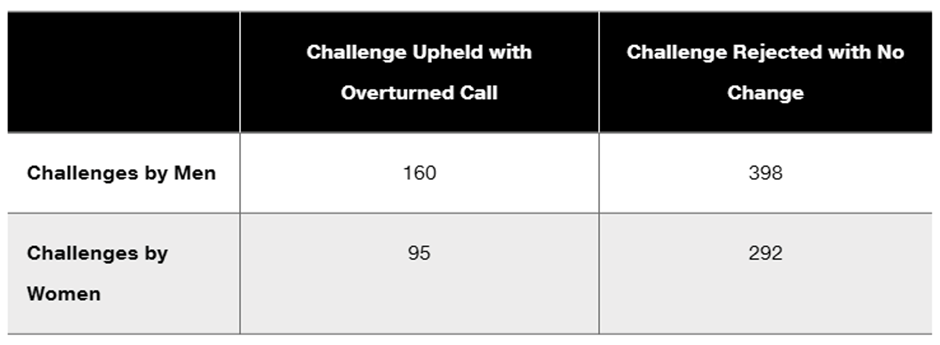 Back
BackProblem 1
Internet Traffic Data Set 27 “Internet Traffic” includes 9000 arrivals of Internet traffic at the Digital Equipment Corporation, and those 9000 arrivals occurred over a period of 19,130 thousandths of a minute. Let the random variable x represent the number of such Internet traffic arrivals in one thousandth of a minute. It appears that these Internet arrivals have a Poisson distribution. If we want to use Formula 5-9 to find the probability of exactly 2 arrivals in one thousandth of a minute, what are the values of μ, x, and e that would be used in that formula?
Problem 3
For the distribution described in Exercise 1, find the probability of exactly 2 arrivals in one thousandth of a minute.
Problem 5.C.1.5
Planets The planets of the solar system have the numbers of moons listed below in order from the sun. (Pluto is not included because it was uninvited from the solar system party in 2006.) Include appropriate units whenever relevant.
0 0 1 2 17 28 21 8
i. What is the level of measurement of the data: nominal, ordinal, interval, or ratio?
j. Are the data discrete or continuous?
Problem 5.CRE.1ab
Planets The planets of the solar system have the numbers of moons listed below in order from the sun. (Pluto is not included because it was uninvited from the solar system party in 2006.) Include appropriate units whenever relevant.
0 0 1 2 17 28 21 8
a. Find the mean.
b. Find the median.
Problem 5.CRE.1cd
Planets The planets of the solar system have the numbers of moons listed below in order from the sun. (Pluto is not included because it was uninvited from the solar system party in 2006.) Include appropriate units whenever relevant.
0 0 1 2 17 28 21 8
c. Find the mode.
d. Find the range.
Problem 5.c.1e
Planets The planets of the solar system have the numbers of moons listed below in order from the sun. (Pluto is not included because it was uninvited from the solar system party in 2006.) Include appropriate units whenever relevant.
0 0 1 2 17 28 21 8
e. Find the standard deviation.
f. Find the variance.
Problem 5.q.6
In Exercises 6–10, refer to the accompanying table, which describes the numbers of adults in groups of five who reported sleepwalking (based on data from “Prevalence and Comorbidity of Nocturnal Wandering In the U.S. Adult General Population,” by Ohayon et al., Neurology, Vol. 78, No. 20).
Does the table describe a probability distribution?
Problem 5.q.7
In Exercises 6–10, refer to the accompanying table, which describes the numbers of adults in groups of five who reported sleepwalking (based on data from “Prevalence and Comorbidity of Nocturnal Wandering In the U.S. Adult General Population,” by Ohayon et al., Neurology, Vol. 78, No. 20).
Probability Find the probability that at least one of the subjects is a sleepwalker.
Problem 5.Q.10
In Exercises 6–10, refer to the accompanying table, which describes the numbers of adults in groups of five who reported sleepwalking (based on data from “Prevalence and Comorbidity of Nocturnal Wandering In the U.S. Adult General Population,” by Ohayon et al., Neurology, Vol. 78, No. 20).
Significant Events Is 4 a significantly high number of sleepwalkers in a group of 5 adults? Explain.
Problem 5.R.1
In Exercises 1–5, assume that 4.2% of workers test positive when tested for illegal drugs (based on data from Quest Diagnostics). Assume that a group of ten workers is randomly selected.
Workplace Drug Testing Find the probability that exactly two of the ten workers test positive for illegal drugs.
Problem 5.R.2
In Exercises 1–5, assume that 4.2% of workers test positive when tested for illegal drugs (based on data from Quest Diagnostics). Assume that a group of ten workers is randomly selected.
Workplace Drug Testing Find the probability that at least one of the ten workers tests positive for illegal drugs.
Problem 5.R.3
In Exercises 1–5, assume that 4.2% of workers test positive when tested for illegal drugs (based on data from Quest Diagnostics). Assume that a group of ten workers is randomly selected.
Workplace Drug Testing Find the mean and standard deviation for the numbers of workers in groups of ten who test positive for illegal drugs.
Problem 5.R.4
In Exercises 1–5, assume that 4.2% of workers test positive when tested for illegal drugs (based on data from Quest Diagnostics). Assume that a group of ten workers is randomly selected.
Workplace Drug Testing If none of the ten workers tests positive for illegal drugs, is that a significantly low result?
Problem 5.RE.5
In Exercises 1–5, assume that 4.2% of workers test positive when tested for illegal drugs (based on data from Quest Diagnostics). Assume that a group of ten workers is randomly selected.
Workplace Drug Testing If four of the ten workers test positive for illegal drugs, is that a significantly high result?
Problem 5.RE.6
Acrophobia USA Today reported results from a survey in which subjects were asked if they are afraid of heights in tall buildings. The results are summarized in the accompanying table. Does this table describe a probability distribution? Why or why not?
Problem 5.c.3d
Tennis Challenge In a recent U.S. Open tennis tournament, there were 945 challenges made by singles players, and 255 of them resulted in referee calls that were overturned. The accompanying table lists the results by gender.
d. If 1 of the 945 challenges is randomly selected, find the probability that it was made by a man or was upheld with an overturned call.
Problem 5.c.3e
Tennis Challenge In a recent U.S. Open tennis tournament, there were 945 challenges made by singles players, and 255 of them resulted in referee calls that were overturned. The accompanying table lists the results by gender.
e. If one of the challenges is randomly selected, find the probability that it was made by a man, given that the challenge was upheld with an overturned call.
Problem 5.c.4a
Salary Negotiations In a Jobvite survey, 2287 adult workers were randomly selected and asked about salary negotiations.
a. 29% of the respondents reported that they negotiated salary at their latest job. What is the number of respondents who reported that they negotiated salary?
Problem 5.c.4b
Salary Negotiations In a Jobvite survey, 2287 adult workers were randomly selected and asked about salary negotiations.
b. Among those who negotiated salary, 84% received higher pay. How many received higher pay?
Problem 5.c.8
Happiness In a survey sponsored by Coca-Cola, subjects were asked what contributes most to their happiness, and the table summarizes their responses. Does the table represent a probability distribution? Explain.
Problem 5.RE.8
Family/Partner Groups of people aged 15–65 are randomly selected and arranged in groups of six. The random variable x is the number in the group who say that their family and/or partner contribute most to their happiness (based on a Coca-Cola survey). The accompanying table lists the values of x along with their corresponding probabilities. Does the table describe a probability distribution? If so, find the mean and standard deviation.
Problem 5.CRE.2a
Kentucky Pick 4 In the Kentucky Pick 4 lottery game, you can pay $1 for a “straight” bet in which you select four digits with repetition allowed. If you buy only one ticket and win, your prize is $2500.
a. If you buy one ticket, what is the probability of winning?
Problem 5.CRE.2b
Kentucky Pick 4 In the Kentucky Pick 4 lottery game, you can pay $1 for a “straight” bet in which you select four digits with repetition allowed. If you buy only one ticket and win, your prize is $2500.
b. If you play this game once every day, find the mean number of wins in years with exactly 365 days.
Problem 5.CRE.2c
Kentucky Pick 4 In the Kentucky Pick 4 lottery game, you can pay $1 for a “straight” bet in which you select four digits with repetition allowed. If you buy only one ticket and win, your prize is $2500.
c. If you play this game once every day, find the probability of no wins in 365 days.
Problem 5.CRE.3a
Tennis Challenge In a recent U.S. Open tennis tournament, there were 945 challenges made by singles players, and 255 of them resulted in referee calls that were overturned. The accompanying table lists the results by gender.
a. If 1 of the 945 challenges is randomly selected, what is the probability that it resulted in an overturned call?
Problem 5.CRE.3b
Tennis Challenge In a recent U.S. Open tennis tournament, there were 945 challenges made by singles players, and 255 of them resulted in referee calls that were overturned. The accompanying table lists the results by gender.
b. If one of the overturned calls is randomly selected, what is the probability that the challenge was made by a woman?
Problem 5.CRE.3c
Tennis Challenge In a recent U.S. Open tennis tournament, there were 945 challenges made by singles players, and 255 of them resulted in referee calls that were overturned. The accompanying table lists the results by gender.
c. If two different challenges are randomly selected without replacement, find the probability that they both resulted in an overturned call.
Problem 5.Q.4
Find the mean of the random variable x described in the preceding exercise.
Problem 5.Q.5
Is the mean found in the preceding exercise a statistic or a parameter?
Problem 5.R.10a
Poisson: Deaths Currently, an average of 7 residents of the village of Westport (population 760) die each year (based on data from the U.S. National Center for Health Statistics).
a. Find the mean number of deaths per day.

